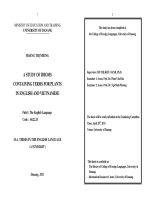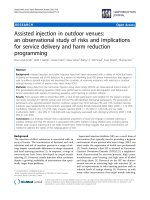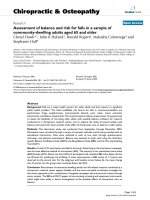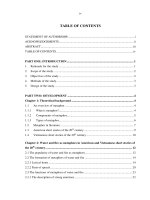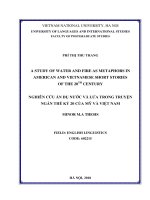An American-Vietnamese Cross-cultural Study of Interrupting and Asking for Clarification in Business Meetings
Bạn đang xem bản rút gọn của tài liệu. Xem và tải ngay bản đầy đủ của tài liệu tại đây (193.56 KB, 13 trang )
VIETNAM NATIONAL UNIVERSITY, HANOI
UNIVERSITY OF LANGUAGES AND INTERNATIONALSTUDIES
FACULTY OF POST-GRADUATE STUDIES
BÙI THỊ MAI
AN AMERICAN –VIETNAMESE CROSS –CULTURAL STUDY
OF INTERRUPTING AND ASKING FOR CLARIFICATION IN
BUSINESS MEETINGS
(Nghiên cứu giao văn hóa Việt-Mỹ về cách thức ngắt lời và yêu cầu
làm rõ ý trong các cuộc họp kinh doanh)
M.A. MINOR PROGRAMME THESIS
Field: English Linguistics
Code: 60220201
HANOI – 2016
VIETNAM NATIONAL UNIVERSITY, HANOI
UNIVERSITY OF LANGUAGES AND INTERNATIONALSTUDIES
FACULTY OF POST-GRADUATE STUDIES
BÙI THỊ MAI
AN AMERICAN –VIETNAMESE CROSS –CULTURAL STUDY
OF INTERRUPTING AND ASKING FOR CLARIFICATION IN
BUSINESS MEETINGS
(Nghiên cứu giao văn hóa Việt-Mỹ về cách thức ngắt lời và yêu cầu
làm rõ ý trong các cuộc họp kinh doanh)
M.A. MINOR PROGRAMME THESIS
Field: English Linguistics
Code: 60220201
Supervisor: Prof. NGUYỄN QUANG, Ph.D.
HANOI – 2016
DECLARATION
I certify that the work presented in this research report has been performed and
interpreted solely by myself. I confirm that this paper is submitted in fulfillment of the
requirement for the M.A. Degree and has not been submitted elsewhere in any other
form for the fulfillment of any other degree or qualification.
Hanoi, 2016
Bùi Thị Mai
1
ACKNOWLEDGEMENTS
This M.A thesis could not have been accomplished without the invaluable
help, encouragement and support form a number of people who I would like to show
my sincerest gratitude and appreciation.
To begin with, I would like to express my greatest and deepest thankfulness to
Prof. Nguyen Quang, my supervisor, for his enthusiastic and precious guideline and
advice throughout the duration of my thesis. Without his instruction and supervision,
this thesis could not have reached the fulfillment.
Additionally, I wish to send my special thanks to Mr. Hoang Van Nam, a sales
representative at Danko Logistic Company, for his wholehearted facilitation. Without
his support, I cannot obtain emails for contacting American and Vietnamese
businesspeople to ask for their participation in my study. Thus, my honest thanks also
come to the American and Vietnamese businesspeople who passionately provide their
responses to my DCT and MCQ.
Last but not least, I owe a great debt of gratitude to my family and
relatives particularly my father, mother and brother who have always supported
me and supplied the best conditions for me to complete this thesis.
2
ABSTRACT
This paper is carried out at endeavor of exploring the linguistic politeness
strategies utilized by the Vietnamese and the American businesspeople in making
interruption and asking for clarification in business meetings. From that, major
similarities and differences between the two languages in this regard are revealed.
On the basis of quantitative method, discourse completion task (DCT) is
employed to collect data from participants including thirty Vietnamese native speakers
and American ones who are currently working in business sector. The result reveals
that the positive politeness strategy namely “minimizing imposition” is the most
common strategy used by American businesspeople while their Vietnamese
counterparts prefer “apologizing and minimizing imposition” in semiformal and
informal business meetings. Moreover, the speaker‟s ages, genders and positions have
great influence on the choice of politeness strategy for Vietnamese businesspeople
while those factors make no significant influence on the American ones.
3
CHAPTER I: INTRODUCTION
1. Rationale
Language has become an indispensable part in the development and civilization
of human beings. Language is not only for communication but also for cultural
exchange among nations. The close association between language and culture is
undeniable. Hence, it is very difficult for an individual to acquire a language without
studying and understanding its culture.
Cross-cultural communication is an interesting and attractive field to find out
the similarities and differences between languages and cultures in various situations in
terms of speech acts and politeness strategies. Many studies regarding the speech acts
of requesting, giving and receiving compliments, promising and soon have been carried
out in Vietnam and in other countries where learners of English are of different
language backgrounds. However, „interrupting and asking for clarification‟ in
conversations in general and in the context of business meetings in particular is one of
the areas that is not paid much attention to.
There are different ways to interrupt and ask for clarification in Vietnamese and
in American English. However, how to interrupt politely and get effectiveness of
clarifying are by no means easy. People often have difficulties selecting appropriate
and polite ways to interrupt another person in another language and in different
contexts. This leads the author to the decision to conduct research into “An American –
Vietnamese cross-cultural study of interrupting and asking for clarification in business
meetings” to find out the similarities and differences in how businesspeople interrupt
and ask for clarification in these situations in the two different languages and cultures.
2. Significance of the study
Finding out the similarities and differences in interrupting and asking for
clarification between Vietnamese and American entrepreneurs in the context of
business meetings is expected to make a significant contribution to cross-cultural
4
pragmatics in theory, and effective communication in practice. Therefore, Vietnamese
businesspeople can be more confident when communicating and attending business
meetings with American counterparts.
3. Aims and objectives of the study
3.1. Aims of the study
In the light of cross-cultural pragmatics, this study aims at comparing and
contrasting linguistic politeness strategies in the speech acts of interrupting and asking
for clarification employed by American businesspeople and their Vietnamese
counterparts in business meeting context.
3.2. Objectives of the study
The study is designed:
firstly, to investigate ways of interrupting and asking for clarification in
business meetings in Vietnamese and American English;
secondly, to compare and contrast the use of politeness strategies in the
ways the Vietnamese and American businesspeople interrupt and ask for
clarification in business meetings
4. Scope of the study
The
English-speaking informants to be surveyed
are
all
American
businesspeople and their Vietnamese-speaking counterparts are all Northern
Vietnamese.
The study only focuses on the verbal aspects of interrupting and asking for
clarification. The analysis of the data collected from the survey questionnaire
concentrates on the ways the American and Vietnamese businesspeople of different
ages, genders and positions interrupt and ask for clarification in business meetings.
This would mean major similarities and differences between the two cultures would be
drawn out from the analysis of the use of negative politeness and positive politeness
strategies.
5
5. Research questions
To fulfill the objectives above, the answers to the following research questions are
sought:
1. What
politeness
strategies
are
used
by
American
and
Vietnamese
businesspoeple in interrupting and asking for clarification in business meetings?
2. What are the major similarities and differences in interrupting and asking for
clarification in terms of politeness strategies between the Vietnamese and
American businesspeople?
6. Research method
The main method of this study is quantitative. All the considerations, remarks,
interpretations, comments and assumptions given in this study are based largely on the
analysis of statistic data with reference to publications. The practical access includes:
conducting survey questionnaires, studying relevant publications, discussing with
American and Vietnamese colleagues, and consulting with the supervisor.
Survey research is the method of gathering data from respondents supposed to
be representatives of some population. In this survey, the author samples a population.
Since populations can be quite large, the researcher directly questions only sample of
the population. Therefore, this method allows the researcher to gain potential
generalizability. Besides, survey research tends to be reliable method if questionnaires
are well-constructed and standardized, (Blackstone, 2012).That is the reason why
survey method is employed in this study.
7. Structure of the study
The thesis consists of the followings:
Chapter I: INTRODUCTION
This chapter includes the rationale, aims, objectives and scope of the study.
Chapter II: THEORETICAL BACKGROUND
6
Such key concepts as culture, cross-culture, speech acts, and politeness are defined,
and politeness principles, politeness strategies in interrupting and asking for
clarification are critically discussed. Also, a review of related studies will be presented.
Chapter III: METHODOLOGY
This chapter provides a methodological framework for collecting and analyzing data.
Chapter IV: DATA ANALYSIS AND FINDINGS
In this chapter, data analysis and findings of the study are presented with the
illustration of tables and charts.
Chapter V: CONCLUSION
Summary of the major findings and suggestions for further research are presented in
this part.
7
REFERENCES
Anderson, K. & Leaper, C. (1998). "Meta-Analysis of gender effects on conversational
interruption: who, what, when, where and how." Sex Roles, 39(3/4): 225-252.
Adler, N. J., & Gundersen, A. (2008).International dimensions of organizational
behavior (5th ed.).Mason, OH: Thomson South-Western.
Austin,J.L. (1962). How to do things with words. New York: Oxford University Press.
Barron, A. (2003). Acquisition in interlanguage pragmatics. Learning how to do things
with words in a study abroad context. Philadelphia: John Benjamins Publishing
Company.
Blackstone, A. (2012). Principles of Sociological Inquiry: Qualitative and quantitative
methods, v.1.0. Retrieved from />Brown, P. & Levinson, S. (1987). Politeness: Some Universals in Language Usage.
Cambridge: Cambridge University Press.
Chambers, K. (1997). Succeed in business: Vietnam. The essential guide for business
and investment. Portland, OR: Graphics Arts Center.
Gallagher, R. S. (2003). The soul of an organization: Understanding the values that
drive successful corporate cultures. La Crosse, Wisconsin: Dearborn Trade Publishers,
pp.4-6.
Gary, R. W. (1999). American cultural values. Kokusai Bunka Kenshu (Intercultural
Training), Special Edition, pp. 9-15.
Gesteland, R.R. (1999). Cross-culture business behavior. Herndon, VA: Copenhagen
Business School Press.
Holmes, J. (2009). Politeness Strategies as Linguistic Variables, In Keth Brown and
Keth
Allan (eds.),
Concise Encyclopedia of Semantics.
Boston,Heidelberg, London, New York, Oxford, pp.699-711.
8
Elselver.Amsterdam,
Hong,Y., & Chiu, C. (2001).Toward a paradigm shift: From cross-cultural differences
in social cognition to social-cognitive mediation of cultural differences.Social
Cognition, 19, 181-196.
James, D.,& Clarke, S. (1988). "Women, Men, and Interruptions:
A Critical
Review."Pp.231-80 in Gender and Conversational Interaction, edited by Deborah
Tannen. New York: Oxford University Press.
Jia,Y. (1997). Communication between Cultures. Shanghai: Shanghai Foreign
Language Education Press
John, H. (2008). Cultural Differences in Business Communication. Tepper School of
Business: Carnegie Mellon University.
Katrine, S.K. (2007). American doing business in Vietnam: Communication
differences.COM 9656: International Business Communication
Kramsch, C. (1998). Language and culture.Oxford University Press.
Levine, D. R., & Adelman, M. B. (1993). Beyond language: Cross-cultural
communication. Englewood Cliffs, N.J: Prentice Hall Regents.
Locastro, V. (2012).Pragmatics for Language Educators: A Sociolinguistic
Perspective. New York: Routledge.
McCarthy, M. P. D. (1994).International Business History: A Contextual and Case
Approach. Praeger
Menz, F. & Al-Roubaie, A. (2008)."Interruptions, status and gender in medical
interviews: the harder you brake, the longer it takes." Discourse & Society 19(5): 645666.
Nguyen Quang. (2003). Intracultural and Cross-cultural Communication.VNU Press.
O'Reilly, M. (2008)."What value is there in children's talk? „Investigating family
therapists' interruptions of parents and children during the therapeutic process".
Journal of Pragmatics40 (3): 507-524
9
Roger, D. B., & Schumacher, A. (1983).Effects of individual differences on dyadic
conversational strategies. Journal of Personality and Social Psychology, 45, 700-705.
Searle, J. R. (1976). "The classification of illocutionary acts". Language in Society 5:
1-24.
Segall, M. H., Dasen, P. R., Berry, J. W., &Poortinga, Y. H. (1999).Human behavior in
global perspective(2nd ed.). Boston, MA: Allyn& Bacon
Searl, J.R. (1976). The classification of illocutionary acts. Language in Society, 5, 1-23
Watts, J.R. (2003). Politeness. Cambridge: Cambridge University Press
Wierzbicka, A. (1991).Cross-cultural Pragmatics: The Semantics of Human
Interaction. Berlin - New York: Mouton de Gruyter
Yin, J. (2002).Telling the truth? A cultural comparison of “facilitating discussion” in
American talk. Discourse Processes, 33, 235–256.
Yule, G. (1996). Pragmatics.Oxford University Press.
Zimmerman, D. & West, C. (1975). "Sex Roles, Interruptions and Silences in
Conversations." Pp. 105-29 in Language and Sex: Difference and Dominance, edited
by Barrie Thorne and Nancy Henley. Rowley, MA: Newbury House.
Zhao, X. &Gantz, W. (2003). "Disruptive and Cooperative Interruptions in PrimeTime Television Fiction: The Role of Gender, Status, and Topic. “Journal of
Communication53(2): 347-362.
10
I
